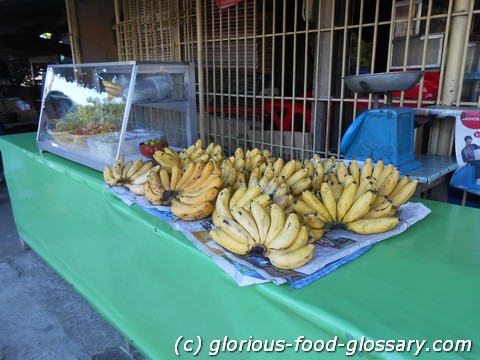Deutsch: Banane (Lakatan) / Español: Banana (Lakatan) / Português: Banana (Lakatan) / Français: Banane (Lakatan) / Italiano: Banana (Lakatan)
Saging (Lakatan) refers to a specific variety of banana that is popular in the Philippines and other parts of Southeast Asia. The Lakatan banana is known for its vibrant yellow-orange color when ripe, which distinguishes it from the more widely known Cavendish bananas that are a lighter yellow. Lakatan bananas are smaller and thicker than Cavendish bananas, with a sweeter flavor and firmer flesh, making them a preferred choice for eating fresh rather than for cooking.
Description
Lakatan bananas are highly valued for their rich, sweet taste and creamy texture, which makes them a favorite snack and a common ingredient in desserts and fruit salads in Filipino cuisine. Unlike the green cooking bananas or plantains, Lakatan bananas are consumed when fully ripe. Their nutritional profile includes a good source of vitamins A, C, and potassium, contributing to their appeal as a healthy snack option.
Application Areas
In the culinary world, Saging (Lakatan) is primarily consumed fresh, directly as a fruit. However, it also features prominently in various dishes, including breakfast cereals, smoothies, and baked goods like banana bread and muffins. In the Philippines, it is common to find Lakatan bananas used in traditional desserts such as "turon" (banana lumpia), "maruya" (banana fritters), and "halo-halo" (a mixed ice dessert), among others.
Well-Known Examples
While Saging (Lakatan) itself is a specific banana variety, it shares the stage with other banana types in Filipino cuisine, such as the Saba and Tundan varieties. Each type has its preferred uses, with Saba being more commonly used for cooking and Lakatan for fresh consumption. The versatility of bananas in Filipino and Southeast Asian cuisine showcases the fruit's cultural and culinary significance.
Treatment and Risks
Lakatan bananas, like other banana varieties, are generally safe and beneficial to consume, offering dietary fiber, vitamins, and minerals. However, individuals with specific health conditions, such as diabetes, may need to monitor their intake of sweet fruits, including Lakatan bananas, due to their natural sugar content. Proper storage is also essential to prevent premature ripening or spoilage; Lakatan bananas should be stored at room temperature and consumed when they reach their peak ripeness for the best flavor and texture.
Recipes
Simple Banana Smoothie Recipe using Lakatan:
Ingredients:
- 2 ripe Lakatan bananas, peeled
- 1 cup milk (dairy or any plant-based alternative)
- 1/2 cup plain yogurt
- Ice cubes
- Honey or sugar to taste (optional)
- In a blender, combine the Lakatan bananas, milk, yogurt, and ice cubes.
- Blend until smooth and creamy. Add honey or sugar if desired, and blend again to incorporate.
- Taste and adjust sweetness if necessary.
- Pour the smoothie into glasses and serve immediately for a refreshing and nutritious drink.
Similar Terms or Synonyms
While Saging (Lakatan) specifically refers to the Lakatan variety of bananas, the term "saging" alone broadly covers all types of bananas in the Filipino language. Other varieties include "Saging na Saba," which is commonly used for cooking, and "Saging na Tundan," which is another type of sweet banana.
Summary
Saging (Lakatan) is a distinct and favored banana variety in the Philippines, prized for its sweet taste, creamy texture, and nutritional value. It's enjoyed fresh and plays a vital role in various Filipino desserts and snacks. As a versatile and nutritious fruit, Lakatan bananas are a staple in Filipino households, reflecting the broader cultural significance of bananas in the country's culinary traditions.
--

Related Articles to the term 'Saging (Lakatan)' | |
| 'Saging na Saba (Hinog)' | ■■■■■■■■■■ |
| Saging na Saba (Hinog) refers to the ripe version of the Saba banana, a type of cooking banana that is . . . Read More | |
| 'Lakatan' | ■■■■■■■■■■ |
| Lakatan refers to a variety of banana that is widely cultivated and consumed in the Philippines. Known . . . Read More | |
| 'Saging na Saba (Hilaw)' | ■■■■■■■■ |
| Saging na Saba (Hilaw) refers to the unripe, green version of the Saba banana, a type of cooking banana . . . Read More | |
| 'Maruya' | ■■■■■■ |
| Maruya is a traditional Filipino snack made from bananas, typically saba bananas, which are battered . . . Read More | |
| 'Huckle Berry Ice Cream' | ■■■■■■ |
| Huckle Berry Ice Cream: Huckleberry Ice Cream in the food context refers to ice cream flavored with huckleberries, . . . Read More | |
| 'Persimmon' | ■■■■■■ |
| Persimmon is a type of fruit that comes from trees belonging to the genus Diospyros. Known for their . . . Read More | |
| 'Puso ng Saging' | ■■■■■ |
| Puso ng Saging, also known as banana blossom or banana heart, is a tear-shaped, purple-skinned flower . . . Read More | |
| 'Banana' | ■■■■■ |
| Banana: A banana is an edible fruit produced by several kinds of large herbaceous flowering plants of . . . Read More | |
| 'Chowders' | ■■■■■ |
| Chowders is a type of thick hearty soups are made from fish, shellfish and/or vegetables and often contain . . . Read More | |
| 'Choron' | ■■■■■ |
| Choron (a la Choron ) refers to a garmish made from artichoke hearts (artichoke bottom) filled with green . . . Read More | |
